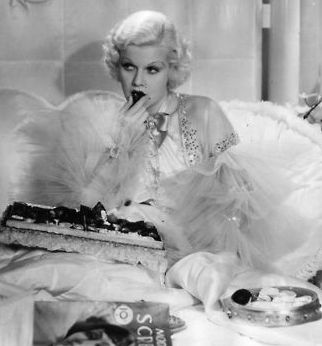By Lucia Adams

Marie Dressler as Carlotta Vance in Dinner at Eight and Lionel Barrrymore as Oliver Jordan.
It’s 1933, the Great Depression is in full swing, “Everybody’s broke, Darling”, everybody’s cheating, husbands, wives, businessmen, even the President and “everything’s the matter with the affairs of the nation.” To top it off the wrong class torments the right class, vulgar opportunists blackmailing maids, cooks dropping “dressy” aspic on the floor, cheeky bellboys skimming liquor money, butlers knifing chefs, and a Montana miner trying to take over the company of an Old Guard shipping magnate. Although everyone is pulleying themselves up fist by fist there is always something or someone ready to cut the rope.

Billie Burke’s Millicent Jordan.
This early George Cukor film from MGM, adapted for the screen by Herman Mankewicz and Frances Marion from a Kaufman/Ferber stage play bristles with one liners and the resonant proper nouns, “Amsterdam mutton”, the fast set, Antibes, always Antibes, Noel, Winston and Wales as Mrs. Oliver Jordan invites Lord and Lady Ferncliffe, the richest couple in London, to dinner at eight next Friday. There are many hurdles to clear first.
Oblivious to the fact her husband, Oliver, is broke and dying from coronary thrombosis (Lionel Barrymore as a sick man again), Millicent Jordan is in a tizzy trying to find a male dinner partner for Carlotta Vance and round out number twelve for a successful party, though cousin Hattie cries, “they’re invited for dinner not for mating” . At the last minute she invites her 19-year old daughter’s secret lover Larry Renault, “Free white and 45,” or is it 46, but a washed up alcoholic silent film star, living in the Hotel Versailles on East 48th Street.

Madge Evans appearing as Paula Jordan and John Barrymore as Larry Renault.
A rueful John Barrymore in a crested smoking jacket, with seven cents left in its pocket, has just lost a tiny part as a beachcomber in a play. He is brutally humiliated by agents and hoteliers until unable to bear it any longer commits suicide, which deflates this souffle of a movie. Must his character always die?
Dan Packard, the ghastly nouveau riche miner (“he smells Oklahoma”) a predictably evil Wallace Beery with nefarious plans, has a howlingly tacky wife having an affair with her doctor, devastatingly handsome Ed Lowe, a serial adulterer whose his own wife calls him “a shoddy masher.” To round out the bunch of sad sack men is Hattie’s husband, besotted by Greta Garbo and insulting to his forbearing wife. If the men are so flawed, the women are brilliantly comedic, hilarity and farce fading in and out of tragedy and creating discordant notes in the film.

Jean Harlow and Wallace Beery as Kitty and Dan Packard.
The women hold the aces as they always would in Cukor’s films, in this year that the first women were appointed by FDR to the Cabinet and the US Mint. A sublimely silly Billie Burke as Millicent captivates with her high class, high pitched fluttering voice and swooning stance suddenly gone darker when the Ferncliffs stiff her and go fishing in Florida and become “those miserable Cockneys”.

Lionel Barrymore and Billie Burke as the Oliver Jordans.
Learning of her husband’s plight she is ready to make great sacrifices for the marriage and family, quickly picking up the telephone and cancelling a table at a gala.

Marie Dressler’s Carlotta Vance.
Carlotta Vance, “the little girl from Quincy, Illinois”, dazzles in Marie Dressler’s Mannerist performance as a very large, very faded actress and grande horizontale back in New York straight off the Europlane “to mend my shattered fortune”. Greeting men seductively with Ducky or Lochinvar, the flinty old flirt dispenses sage advice about those men who “didn’t often ask me to marry them.” In her last stage role she wore pants and still does as she tells Paula Jordan not to tell her fiance Ernest de Graff about Larry— though like all young people says she has the right to do exactly what she wants to. En route to dinner she gamely chats with Kitty who announces she is reading a book (a book? Carlotta staggers) about machines replacing men, and eyeing the very revealing pre-Code gowned harlot, exclaims she’ll never have to worry about that.

Jean Harlow’s Kitty Packard.
Blindingly platinum Kitty Packard, Jean Harlow in her best Mae West imitation and uncannily prefiguring Marilyn Monroe, a former hatcheck girl at the Hottentot Club, lives in her satin bed eating bon bons and calling her maid “nitwit”. She warns her husband she’ll spill the beans on his crooked schemes if he divorces her or prevents her from going to the hoity toity dinner party. She wants to be a lady, rescues Oliver from total catastrophe and demands respect, which she is accorded by her husband even if he does kick her in the derriere. True to comedic form there is a (somewhat) happy ending to Dinner at Eight, the survivors assembling in the dining room, chastened perhaps but there nonetheless.

The somewhat happy ending.
Cukor mined these characters in later triumphs in a very long career, like The Women, A Star is Born, The Philadelphia Story, My Fair Lady, and for a brief time Gone With the Wind until Clark Gable refused to work with a gay director and Selznick replaced him with Victor Fleming.








